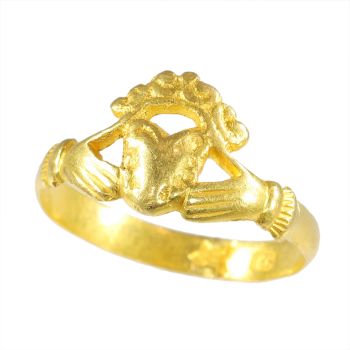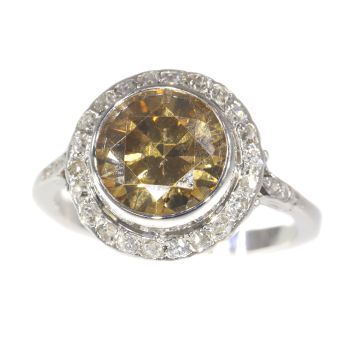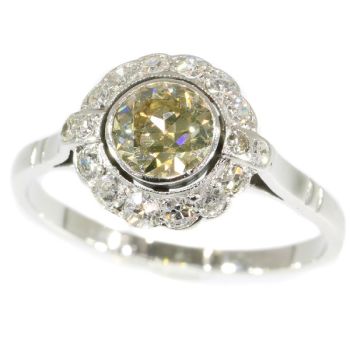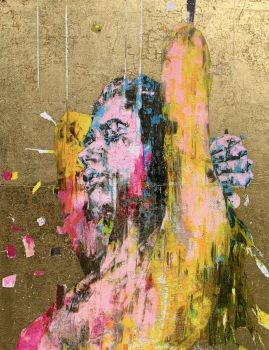Antique 18K Gold Baroque Wedding Band, Circa 1700 – A Timeless Symbol of Love 1700
Artista Desconocido
Oro
€ 8.200
Adin Fine Antique Jewellery
- Sobre la obra de arte
Imagine wearing an antique wedding band from circa 1700, a rare piece crafted in 18K yellow gold, with alternating lozenge shapes and stylised floral motifs set upon delicate filigree wirework. This beautiful ring, with its Baroque charm, is not just apiece of jewellery; it’s a tangible connection to history, symbolising the enduring nature of love. To wear such a ring as a symbol of your marriage is to carry a piece of timeless elegance, a link to centuries past, as you begin your own journeytogether.
Antique jewelry object group
ring, wedding band
Condition
very good condition
more info on our condition scale
Country of origin
Netherlands
Style
Baroque - Baroque is an artistic style that dominated Europe from the late 16th century to the early 18th century. Often described as "the leading style in European art between the Mannerist and Rococo periods, characterised by dynamic movement,heightened emotion, and bold expression."
Find more info on Baroque
more info on styles
Style specifics
Baroque is a style in art and decoration that developed shortly before 1600 and remained current in Europe until the emergence of the Rococo style c.1730. It was started in Italy, and spread to Germany, Austria, the Low Countries, and Spain andPortugal, with only a somewhat severely classical version being popular in France under Louis XIV. The style was a development of the Renaissance style and is characterized by lively, curved, and exuberant forms, by vigorous movement, and by richornament, based on classical sources, being symmetrical as distinguished from the asymmetry of the following Rococo style.
Period
ca. 1700
Events & facts of this era, poetry of this era, fashion of this era.
Material 18K
warm yellow gold (touchstone tested)
more info on precious metals
Technique
This jewel features a filigree decoration, which is in fact thin gold wire twisted into refined motifs, in this case elegant little balls. You can also notice the use of granulation on this piece. Granulation is a technique where the goldsmith uses very small balls (granules) of metal, which are not soldered to the piece but welded. Both techniques demand very high skills and precision from the maker.
Hallmarks
On the outside of the ring is a hallmark from the Kingdom of the Netherlands, a flowered letter V, used for foreign and small domestic works between 1814 and 1831. On the inside, there are older hallmarks that require further research, but one appears to resemble a 'U' shape, with a standing lozenge between the open arms of the 'U', possibly encircled by a halo-like feature (possibly a year letter?). The distinct character of these marks suggests that the ring could date back to around 1700.
more info on hallmarks
Dimensions
band width 0,75 cm (0,30 inch)
see picture with a ruler in millimeters and inches
Weight
4,30 gram (2,76 dwt)
Ring size Continental EU: 62 & 19¾ , Size USA: 10 , Size UK: T½
Resizing
Resizing is possible but because of the age of the ring we prefer to leave it untouched. Return policy on this ring is not valid anymore once this work has been done.
more info on ring sizes
Adin Reference Nº
24121-0313
Copyright photography
Adin, fine antique jewellery
Additional information
our latest acquisitions
jewelry glossary
wall of fame
visit us in Antwerp
subscribe to our mailinglist
- Sobre el artista
Puede suceder que un artista o creador sea desconocido.
Algunas obras no deben determinarse por quién está hecho o por (un grupo de) artesanos. Algunos ejemplos son estatuas de la Antigüedad, muebles, espejos o firmas que no son claras o legibles, pero también algunas obras no están firmadas en absoluto.
También puedes encontrar la siguiente descripción:
•"Atribuido a …." En su opinión, probablemente una obra del artista, al menos en parte.
•“Estudio de….” o “Taller de” En su opinión, una obra ejecutada en el estudio o taller del artista, posiblemente bajo su supervisión
•“Círculo de…” En su opinión, una obra del período del artista que muestra su influencia, estrechamente asociado con el artista pero no necesariamente su alumno.
•"Estilo de …." o “Seguidor de…”. En su opinión, una obra ejecutada al estilo del artista pero no necesariamente por un alumno; puede ser contemporáneo o casi contemporáneo
•"Manera de …." En su opinión una obra al estilo del artista pero de fecha posterior
•"Después …." En su opinión, una copia (de cualquier fecha) de una obra del artista
•“Firmado…”, “Fechado…” o “Inscrito” En su opinión, la obra ha sido firmada/fechada/inscrita por el artista. La adición de un signo de interrogación indica un elemento de duda.
•“Con firma…”, “Con fecha…”, “Con inscripción…” o “Lleva firma/fecha/inscripción” en su opinión la firma/fecha/inscripción ha sido añadida por alguien que no es el artista
¿Está interesado en comprar esta obra de arte?
Artwork details
Related artworks
Artista Desconocido
Anillo eduardiano con zafiro que cambia de color1910 - 1920
Precio a consultarAns Hemke-Kuilboer Juwelier & Antiquair
1 - 4 / 12 curada por
curada porDanny Bree
Artista Desconocido
A Surinam-themed Amsterdam long-case clock1746 - 1756
Precio a consultarZebregs & Röell - Fine Art - Antiques
 curada por
curada porGallerease Magazine
Eduard Charlemont
‘Allegories of Africa and America’1872
Precio a consultarZebregs & Röell - Fine Art - Antiques
Johannes van Dreght
Antique Dutch still life flowers in vase1740 - 1800
Precio a consultarGallerease Selected
Peter Paul Rubens (circle of)
Portrait of a man dressed up as an oriental man1620 - 1630
Precio a consultarGallerease Selected
1 - 4 / 24- 1 - 4 / 24
- 1 - 4 / 24
- 1 - 4 / 12






























































































